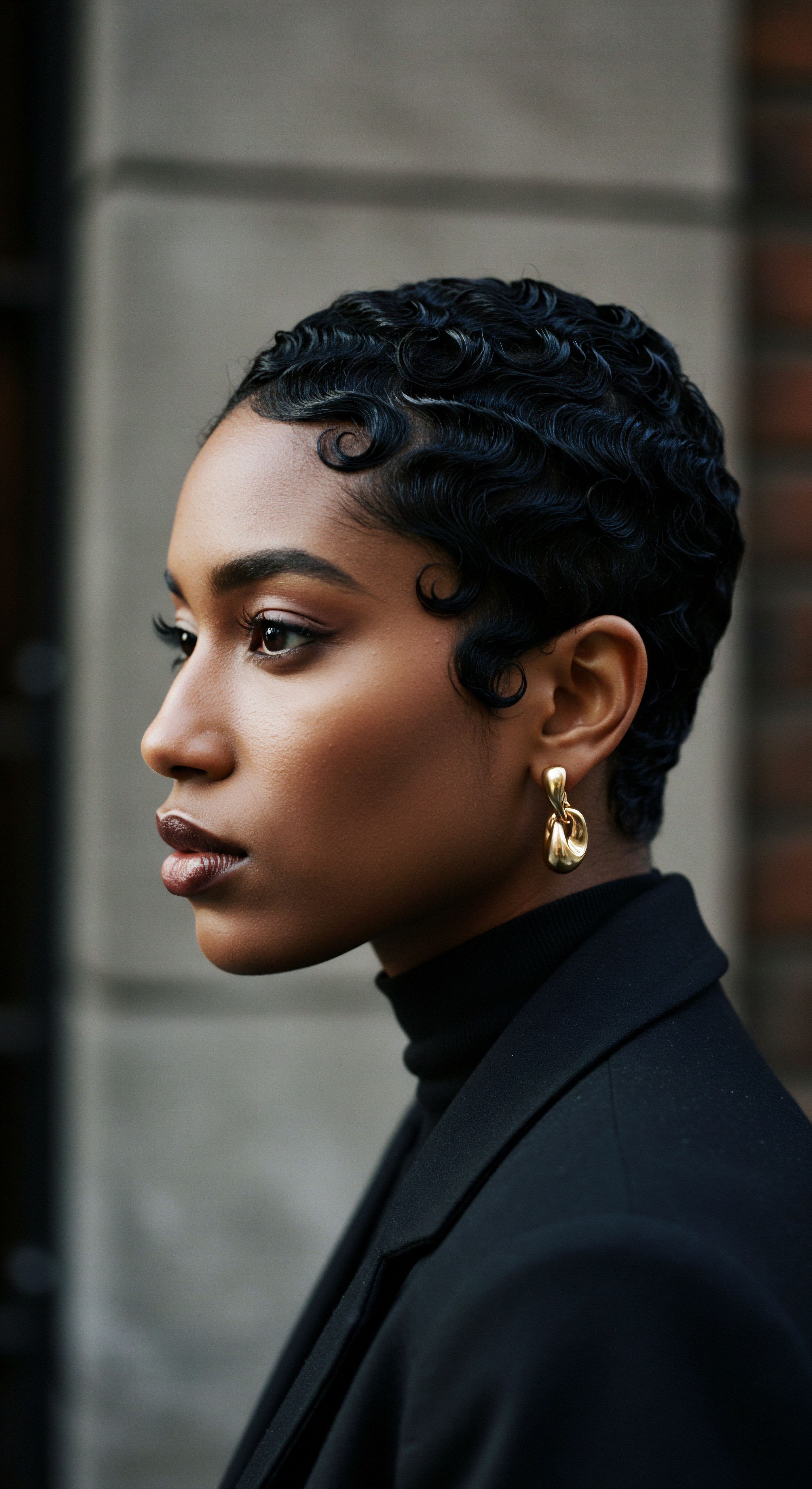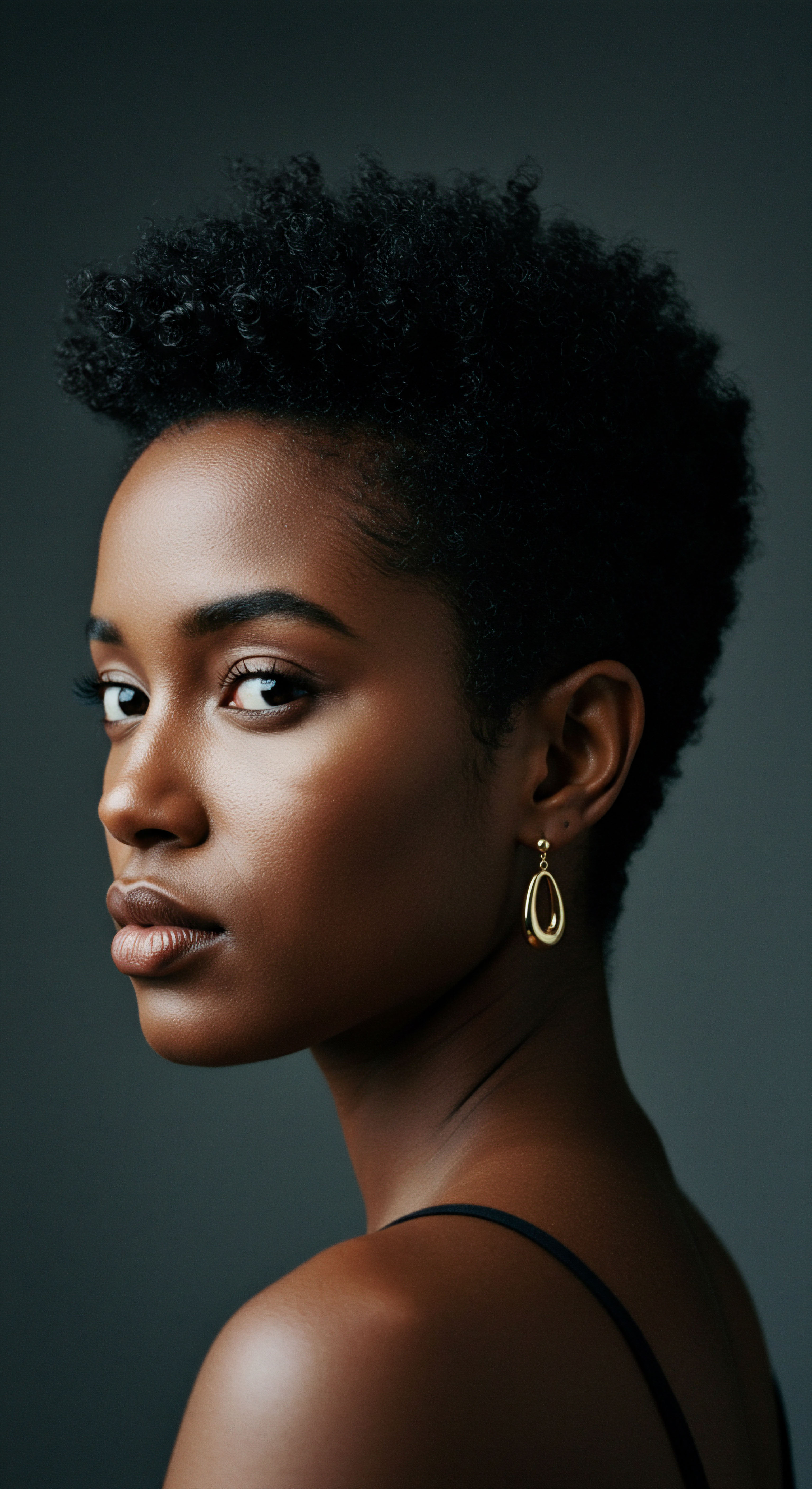
Roots
There exists a quiet wonder in the way our bodies sustain us, a silent symphony of processes often taken for granted. We marvel at the strength of our muscles, the clarity of our minds, the glow of healthy skin. Yet, how often do we truly consider the delicate dance that maintains the vitality of our hair? For those with textured hair, this connection feels particularly profound, a living heritage passed down through generations, holding stories and strength within each coil and strand.
But what happens when the very foundation of our well-being—our rest—falters? Can the hushed hours of slumber truly hold sway over the flourishing of our crowns? The answer, as we shall see, is yes, in ways both subtle and deeply significant.
The conversation surrounding hair health often gravitates toward topical applications, specific products, or styling techniques. While these aspects certainly play a part, the deeper truth resides in the internal rhythms of our being. Just as a plant draws its life from the soil and the sun, our hair draws its vigor from the inner workings of our physiology.
When the internal garden is neglected, even the most diligent external care may find its efforts lessened. This section will begin to peel back the layers, exploring the elemental connection between the restorative power of sleep and the thriving nature of our hair.

The Hair Growth Cycle A Biological Clockwork
Hair growth is not a constant, linear progression. Instead, it unfolds in a beautifully orchestrated cycle, a series of distinct phases that each hair follicle undergoes independently. Understanding this cycle is paramount to grasping how external factors, like insufficient rest, can exert their influence.
- Anagen Phase ❉ This is the active growth period, where hair cells divide rapidly, pushing out new hair. It is the longest phase, lasting anywhere from two to seven years. During this time, the hair follicle is a hub of metabolic activity, demanding a steady supply of nutrients and oxygen to sustain its vigorous production.
- Catagen Phase ❉ A brief transitional stage, typically lasting a few weeks. Growth ceases, and the hair follicle shrinks, preparing for the next stage. It is a period of quiet contraction.
- Telogen Phase ❉ This is the resting phase, where the hair remains in the follicle but is no longer growing. It lasts for about two to four months before the hair sheds, making way for a new anagen phase to begin. A healthy scalp usually has a small percentage of hairs in this resting state.
- Exogen Phase ❉ The final part of the telogen phase, where the old hair sheds. This is a natural and necessary part of the cycle, allowing new hair to emerge.
This cyclical pattern is under the careful guidance of various internal signals, including hormones and cellular communications. Any disruption to these signals can alter the delicate balance, potentially shortening the active growth phase or prematurely ushering hairs into the resting and shedding stages.

Circadian Rhythms and Hair Follicle Activity
Beyond the immediate sensation of tiredness, a deeper biological orchestration governs our sleep and wakefulness ❉ the circadian rhythm. This internal biological clock, synchronized by light and darkness, dictates a roughly 24-hour cycle of physiological and behavioral changes. From body temperature to hormone secretion, these rhythms touch every system within us, including the very cells that give rise to our hair.
The hair follicle itself possesses its own internal circadian clock, a remarkable discovery that highlights the profound connection between our daily rhythms and hair vitality. Specialized clock genes within the hair follicles regulate cell activity across the growth cycle. During the initiation of new hair growth, particularly in the telogen and early anagen phases, there is heightened expression of these circadian clock regulation genes. The secondary hair germ, which contains actively cycling stem and progenitor cells, exhibits some of the most prominent rhythmic circadian gene expression.
Our body’s internal clock, the circadian rhythm, influences hair growth at a cellular level, demonstrating a fundamental link between rest and hair vitality.
When our sleep-wake cycles are disrupted, this internal biological clock falls out of sync. This desynchronization can directly affect how hair stem cells are activated or deactivated, thereby influencing the hair growth cycle itself. For instance, studies have shown that disruptions to key clock genes, such as BMAL1, can lead to inactive stem cells and poor hair growth. This direct cellular impact underscores why consistent, quality rest extends beyond feeling refreshed; it is a foundational requirement for the very genesis of healthy hair.

The Hidden Impact of Hormonal Fluctuations
Sleep is not merely a period of inactivity; it is a time of profound hormonal regulation. Many essential hormones that directly influence hair growth are synthesized and balanced during deep sleep. When rest is insufficient, this delicate hormonal equilibrium can be disturbed, sending ripples through the body that ultimately reach the hair follicles.
One of the primary hormonal players affected by sleep deprivation is Cortisol, often referred to as the stress hormone. When we experience chronic stress, whether from lack of sleep or other life pressures, cortisol levels rise. Sustained high levels of cortisol can push hair follicles prematurely into the resting (telogen) phase, leading to excessive shedding, a condition known as telogen effluvium. This physiological response explains why periods of intense stress often precede noticeable hair thinning.
Conversely, Melatonin, widely known for its role in regulating sleep, also holds significant sway over hair growth. Melatonin receptors are present in hair follicles, suggesting a direct role in controlling the hair’s growth (anagen) and rest (telogen) phases. Adequate melatonin levels appear to stimulate the active growth state of hair follicles, prolonging the anagen phase.
When sleep is poor, melatonin production can be reduced, potentially contributing to slower hair growth or stunted follicles. This connection highlights a fascinating interplay ❉ the hormone that helps us sleep also directly supports the very growth of our hair.
Other hormones, such as Growth Hormone, which promotes cell regeneration, and even Estrogen and Testosterone, also see their levels influenced by sleep quality. Disruptions to these hormonal balances can collectively contribute to hair thinning, breakage, and a general lack of vibrancy. The body operates as a connected system, and when one part falters, others feel the effect.
| Hormone Cortisol |
| Primary Function Stress response, circadian rhythm regulation |
| Impact of Insufficient Rest Elevated levels can prematurely push hair into resting phase, leading to shedding. |
| Hormone Melatonin |
| Primary Function Sleep-wake cycle regulation, antioxidant |
| Impact of Insufficient Rest Reduced levels may shorten hair's active growth phase, impacting density. |
| Hormone Growth Hormone |
| Primary Function Cell regeneration, tissue repair |
| Impact of Insufficient Rest Disrupted production hinders cell repair in hair follicles. |
| Hormone Estrogen & Testosterone |
| Primary Function Influence hair health and growth patterns |
| Impact of Insufficient Rest Imbalance can contribute to thinning hair and slower regrowth. |
| Hormone Maintaining balanced hormone levels through adequate rest supports overall hair health. |

Ritual
As we move from the foundational understanding of how our internal systems affect hair, a natural inclination arises ❉ how do we apply this knowledge? What daily practices, what mindful customs, can we weave into our lives to support the vitality we seek? For those with textured hair, care is often a ritual, a sacred time of connection and attention.
This section steps into that space, exploring the practical wisdom that emerges when we acknowledge the profound link between our rest and the flourishing of our hair. It is about transforming knowledge into gentle, purposeful action, guiding us toward practices that honor our hair’s natural inclination to thrive.
The rhythms of our lives, the choices we make from dusk until dawn, quietly shape the very health of our strands. We often focus on what we apply to our hair, but the truth is, what we do for our bodies, particularly in the realm of rest, creates the most fertile ground for growth. This is not about strict adherence to a rigid schedule, but about cultivating a deeper awareness and respect for the body’s need for restorative peace.

Cultivating a Restful Sanctuary
The environment where we seek rest holds considerable sway over its quality. A tranquil sleeping space can become a true sanctuary, inviting the deep, uninterrupted sleep necessary for cellular repair and hormonal regulation. Consider the elements that contribute to such a haven ❉
- Darkness ❉ Light, even subtle glows from electronic devices, can disrupt melatonin production, signaling to the body that it is still daytime. Creating a truly dark room supports the natural sleep cycle.
- Cool Temperature ❉ A slightly cool room, typically between 60-67 degrees Fahrenheit (15-19 degrees Celsius), aids the body in lowering its core temperature, a necessary step for initiating and maintaining sleep.
- Quiet ❉ Minimizing external noise can prevent awakenings and allow for deeper sleep stages. White noise machines or earplugs can be helpful tools for those in noisy environments.
These environmental considerations, while seemingly simple, collectively contribute to a more profound and uninterrupted period of rest, allowing the body to perform its essential repair functions without hindrance.

The Bedtime Bonnet A Crown’s Best Friend
For textured hair, the nighttime ritual extends beyond just the body’s internal rest; it also involves protecting the hair itself. The friction between textured strands and common pillowcases can lead to breakage, frizz, and moisture loss. This is where the wisdom of the bedtime bonnet, or a silk/satin pillowcase, truly shines.
The practice of covering hair at night is a time-honored tradition in many cultures, particularly within Black communities, recognizing the unique needs of textured hair. A bonnet, or a silk/satin surface, provides a smooth, low-friction environment. This gentle protection prevents the mechanical stress that can lead to weakened strands and split ends.
It also helps to preserve the hair’s natural moisture, which is especially vital for textured hair types prone to dryness. By safeguarding the hair from external aggressors during sleep, we contribute to its overall strength and ability to retain length.
Protecting textured hair at night with a bonnet or silk pillowcase minimizes friction and moisture loss, directly aiding hair strength.
This seemingly small act of care is a powerful component of a holistic hair wellness approach. It is a ritual that honors the hair’s vulnerability during rest and actively supports its structural integrity, allowing the internal restorative processes of sleep to yield their fullest benefits for our strands.

Nourishment for Rest and Hair
The food we consume also plays a part in the quality of our rest and, by extension, the health of our hair. Certain nutrients are particularly helpful in promoting restful sleep and supporting hair growth.
Consider incorporating foods rich in Magnesium, such as leafy greens, nuts, and seeds, which contribute to muscle relaxation and sleep regulation. Tryptophan-Rich Foods like turkey, chicken, and oats can aid in melatonin production. Additionally, ensuring adequate intake of Iron, Zinc, and Biotin, found in sources like lean meats, legumes, and eggs, provides the building blocks necessary for healthy hair growth. These nutritional choices work in concert with sleep to create a supportive internal environment.
Conversely, avoiding stimulants like excessive caffeine and heavy, sugary meals close to bedtime can prevent sleep disruption. The body works hard to digest, and a heavy meal before rest can divert energy from the restorative processes that benefit hair. A lighter, nutrient-dense evening meal supports both digestive ease and sleep quality.

Can a Consistent Sleep Schedule Support Hair’s Vigor?
Just as the body responds to rhythmic patterns in its internal functions, it also benefits from consistency in our daily routines. Establishing a regular sleep-wake schedule, even on weekends, helps to calibrate our internal circadian clock. This regularity reinforces the body’s natural inclination to prepare for sleep and wakefulness at predictable times.
When our sleep schedule is erratic, the body’s internal clock struggles to find its rhythm, leading to a constant state of adjustment. This inconsistency can lead to fragmented sleep, where the body does not spend enough time in the deeper, more restorative sleep stages critical for hormone regulation and cellular repair. For hair, this means less optimal conditions for growth and resilience.
A consistent schedule helps stabilize hormone cycles related to hair growth, allowing follicles to remain in their active growth phase for longer. This deliberate practice of consistent sleep offers a profound yet gentle way to support the hair’s natural vitality, aligning our daily habits with our body’s intrinsic wisdom.
A stable sleep routine reduces the physiological stress that inconsistent sleep patterns can impose. When the body is not constantly battling against a fluctuating internal clock, it can dedicate more resources to maintenance and regeneration, including the continuous cycle of hair growth. This approach moves beyond simply getting “enough” sleep; it focuses on the quality and regularity of that rest, recognizing its power to nurture the hair from within.

Relay
We have explored the foundational truths of sleep’s connection to hair and the daily rituals that can support its flourishing. Now, we delve deeper, moving beyond the surface to consider the intricate biological and even societal currents that shape this relationship. Can the absence of restorative rest truly reach into the very cellular architecture of our strands, altering their destiny?
The answer resides in the nuanced interplay of internal systems, a relay of signals and responses that ultimately manifest in the health and appearance of our hair. This section uncovers the scientific underpinnings and broader implications, revealing a more profound understanding of how our sleep habits echo through our entire being, including the crowns we wear.
The human body is a marvel of interconnected systems, where one seemingly small disruption can cascade into a series of wider effects. Sleep, far from being a passive state, is a period of intense activity, a crucial time for repair, detoxification, and regulation. When this period is cut short or compromised in quality, the consequences extend far beyond simple fatigue, touching the very cellular processes that govern hair growth and resilience.

Does Insufficient Sleep Impact Hair Follicle Stem Cells?
The continuous renewal of hair depends on the tireless work of hair follicle stem cells. These remarkable cells hold the capacity to regenerate new hair follicles and sustain the growth cycle throughout life. Recent scientific inquiry has begun to shed light on how sleep, or its absence, can directly influence these fundamental building blocks of hair.
Research indicates that the circadian clock, which is disrupted by insufficient sleep, plays a direct role in modulating the hair follicle cycle. Studies involving mice with mutations in central clock genes, such as Clock and BMAL1, have shown a significant delay in the progression of the hair growth phase. This suggests that these clock genes influence key cell cycle control genes, effectively halting the proliferation of keratinocytes—the cells that produce hair—in critical compartments of the hair follicles. The implications are significant ❉ when our internal rhythms are disturbed by poor sleep, the very stem cells responsible for initiating new hair growth may become less active or even inactive, leading to poor hair production.
A particularly compelling study from Harvard revealed that elevated cortisol levels, a direct consequence of chronic stress and sleep deprivation, can prevent the regeneration of hair follicles, keeping them in a prolonged resting state. This means that the body struggles to replace lost hair over time if the cycle of stress and inadequate rest persists. This data points to a deeper, cellular level of impact, where the quality of our sleep directly dictates the regenerative capacity of our hair follicles.
Sleep deprivation’s influence extends to hair follicle stem cells, potentially hindering their regenerative capacity and impacting hair growth at its source.

The Immune System’s Role in Hair Health and Sleep
The immune system, our body’s defense network, is profoundly affected by sleep. A well-rested immune system functions optimally, capable of defending against pathogens and maintaining internal balance. Conversely, chronic sleep deprivation can weaken immune responses and promote systemic inflammation. This connection holds direct relevance for hair health.
Inflammation, particularly around the hair follicles, can impede their proper function and lead to various hair concerns. Conditions like seborrheic dermatitis, characterized by itchy, flaky scalp, have been observed to be more prevalent in individuals with sleep disturbances, such as night shift workers. This is attributed to an increase in pro-inflammatory cytokines like TNF-α and reactive oxygen species (ROS), both of which can damage cells and tissues, including those of the scalp and hair follicles.
Furthermore, certain types of hair loss, such as Alopecia Areata, are autoimmune disorders where the immune system mistakenly attacks hair follicles. Research indicates a strong association between alopecia areata and sleep disorders, with individuals experiencing this condition often reporting impaired sleep quality. A large Taiwanese study found that patients with alopecia areata had a significantly higher risk of developing obstructive sleep apnea and non-apnea insomnia.
Conversely, studies also suggest that individuals with sleep disorders face a higher risk of developing alopecia areata, particularly those under 45 years old. This suggests a bidirectional relationship where poor sleep can trigger immune dysregulation, exacerbating autoimmune conditions, and the condition itself can lead to sleep disturbances, creating a self-perpetuating cycle.
The immune system’s intricate dance with sleep underscores that hair health is not an isolated concern; it is deeply intertwined with the body’s overall state of well-being.

Melatonin A Regulator Beyond Sleep
While primarily recognized for its role in sleep regulation, melatonin’s influence extends to various physiological processes, including hair growth. This hormone, secreted by the pineal gland, possesses antioxidant properties and plays a role in immune modulation.
Studies have shown that melatonin receptors are present in human hair follicles, indicating a direct action on hair growth. Topical melatonin treatments have shown promise in clinical studies for individuals with androgenetic alopecia, demonstrating improvements in hair density and thickness. A 2024 review notes that studies have found melatonin to have anti-androgen effects and to be involved in regulating hair growth.
Further research, such as an in vitro study on cashmere goat hair follicles, demonstrated that melatonin promotes the multiplication of hair follicle stem cells, resulting in longer hair shafts. This suggests that melatonin not only helps synchronize the hair cycle but also actively stimulates the growth phase. The implications are significant ❉ optimizing melatonin levels through healthy sleep patterns, or potentially through targeted applications, could be a pathway to supporting robust hair growth.
| Clock Gene BMAL1 |
| Hair Cycle Impact Regulates hair stem cell activity, affects cell cycle progression. |
| Consequence of Disruption Can lead to inactive stem cells and delayed hair growth phase. |
| Clock Gene PER1 |
| Hair Cycle Impact Influences anagen phase duration. |
| Consequence of Disruption Knockdown can prolong anagen, but overall clock disruption is detrimental. |
| Clock Gene CLOCK |
| Hair Cycle Impact Coordinates circadian rhythms, affects hair growth progression. |
| Consequence of Disruption Mutations can cause significant delays in hair growth. |
| Clock Gene Disruptions to these genes, often linked to poor sleep, can alter the hair's natural growth patterns. |

A Controversial Angle The Role of Melatonin Supplementation for Hair
While natural melatonin production is optimized through healthy sleep, the idea of supplementing melatonin for hair growth presents an interesting, perhaps even controversial, discussion point. Some studies suggest that topical melatonin may offer benefits for certain types of hair loss, particularly female pattern hair loss. For example, a study published in the International Journal of Trichology investigated the efficacy of a 0.1% topical melatonin solution in women with androgenetic alopecia.
The findings indicated a statistically significant increase in anagen hair density and a reduction in telogen hair density after 3 and 6 months of application. This outcome, while promising, raises questions about the direct applicability of such findings across all individuals and hair types, particularly textured hair, and whether oral supplementation yields similar localized benefits.
The controversy lies in the fact that while melatonin is naturally produced, external supplementation can have broader systemic effects beyond hair, influencing the body’s natural sleep-wake cycle. The mechanism by which topical melatonin exerts its effects on hair follicles is still under investigation, but it is believed to involve its antioxidant properties and its ability to influence the hair cycle. However, the long-term implications and optimal dosages for diverse populations, especially those with unique textured hair needs, require far more extensive and specific research. This discussion highlights the ongoing scientific exploration and the cautious approach needed when considering interventions that alter the body’s natural hormonal balance.
Topical melatonin shows promise for hair growth in some studies, yet its broader application and long-term effects, especially for textured hair, warrant more investigation.
The question of whether to directly supplement a hormone, even one as seemingly benign as melatonin, for hair health pushes the boundaries of our current understanding. It invites a deeper dialogue about balancing the body’s intrinsic wisdom with targeted interventions, always with an eye toward holistic well-being rather than isolated solutions.

Reflection
As we draw our thoughts together, a clear understanding begins to take shape ❉ the health of our hair, particularly textured hair, is not merely a superficial concern. It is a living testament to the deeper rhythms of our bodies, a reflection of the care we extend to our entire being. The question of whether insufficient rest truly hinders hair growth finds its answer not in a simple ‘yes’ or ‘no,’ but in the intricate dance of hormones, cellular activity, and systemic balance that unfolds within us during our hours of slumber.
To honor our hair, then, is to honor our need for rest, to cultivate a profound respect for the quiet power of renewal that sleep provides. It is a gentle reminder that true vibrancy begins from within, a silent promise whispered from root to tip.

References
- Patel, N. Aschenbrenner, D. S. & Dhurat, R. (2019). Sleep Deprivation as a Stressor in Telogen Effluvium. Sleep Medicine Reviews, 45, 61-72.
- Xerfan, E. M. S. Andersen, M. L. Facina, A. S. Tufik, S. & Tomimori, J. (2021). The role of sleep in telogen effluvium and trichodynia ❉ A commentary in the context of the current pandemic. Journal of Cosmetic Dermatology, 20(4), 1088-1090.
- Lussier, P. S. & Martel, J. A. (2023). Hair Follicles as a Critical Model for Monitoring the Circadian Clock. International Journal of Molecular Sciences, 24(3), 2026.
- Lin, K. Y. et al. (2017). Circadian Clock Genes Contribute to the Regulation of Hair Follicle Cycling. PLOS Genetics, 13(11), e1007026.
- Fischer, T. W. et al. (2004). Melatonin increases anagen hair growth in women with androgenetic alopecia or diffuse alopecia ❉ results of a pilot randomized controlled trial. British Journal of Dermatology, 150(2), 341-345.
- Elma D. Baron, et al. (2019). The Effects of Sleep Deprivation on Skin Health. Journal of Clinical and Aesthetic Dermatology, 12(11), 32-35.
- Oh, J. W. et al. (2014). A Study of the Relationship Between Sleep Quality and Hair Loss in Women. Annals of Dermatology, 26(3), 305-309.
- Wang, B. et al. (2023). Melatonin regulates the periodic growth of secondary hair follicles through the nuclear receptor RORα. Frontiers in Veterinary Science, 10, 1177655.
- Sivamani, R. K. & Wong, S. (2017). How Does the Circadian Rhythm Affect Hair Growth? LearnSkin.
- Grover, C. & Khurana, A. (2013). Telogen Effluvium. Indian Journal of Dermatology, Venereology, and Leprology, 79(5), 591-603.